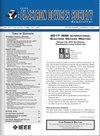Proposing an Accurate and Fast Optical Batch Inspection Method of Mini-/Micro-LEDs
IF 2
3区 工程技术
Q3 ENGINEERING, ELECTRICAL & ELECTRONIC
引用次数: 0
Abstract
Based on the microscopic hyperspectral imaging technique, an optical batch inspection method has been proposed by the authors to efficiently and precisely obtain the absolute emission spectra of red (R), green (G), and blue (B) Mini-/Micro-light-emitting diodes (Mini-/Micro-LEDs). The RGB Mini-LEDs (with a chip area of提出一种准确、快速的微型/超微型 LED 光学批量检测方法
基于显微高光谱成像技术,作者提出了一种光学批量检测方法,以高效、精确地获取红色(R)、绿色(G)和蓝色(B)迷你/微型发光二极管(Mini/Micro-LEDs)的绝对发射光谱。本实验选择了基于 RGB Mini-LED 的阵列(芯片面积为 200 英寸/100 次)。通过所提出的方法,可以详细得出每个 Mini-LED 像素的光度和色度特性。在该方法中,使用了基于 Canny 的优化算法,可在采集的高光谱图像中快速检测有效发光区域,从而为工作人员节省更多时间。与传统的基于积分球的方法相比,拟议方法和传统方法的测量数据相当一致,其最大偏差小于 3.2%。在 300 K 至 340 K 的温度范围内,利用拟议方法获得了每种 Mini-LED 的外部量子效率(EQE)和色度坐标。同时还选择了三个基于RGB Micro-LED(芯片面积为10text{m}/times 10text{m}$)的阵列进行光批量检测,并分析了RGB Micro-LED归一化电致发光(EL)强度的伪彩色图。最后,对 RGB Mini-LED 的光学串扰进行了定量定义和分析。与其他两种微型 LED 相比,红色微型 LED 的光学串扰效应更为突出。结果表明,所提出的方法在 Mini-Micro LED 的批量检测领域具有潜在的应用前景。
本文章由计算机程序翻译,如有差异,请以英文原文为准。
求助全文
约1分钟内获得全文
求助全文
来源期刊

IEEE Journal of the Electron Devices Society
Biochemistry, Genetics and Molecular Biology-Biotechnology
CiteScore
5.20
自引率
4.30%
发文量
124
审稿时长
9 weeks
期刊介绍:
The IEEE Journal of the Electron Devices Society (J-EDS) is an open-access, fully electronic scientific journal publishing papers ranging from fundamental to applied research that are scientifically rigorous and relevant to electron devices. The J-EDS publishes original and significant contributions relating to the theory, modelling, design, performance, and reliability of electron and ion integrated circuit devices and interconnects, involving insulators, metals, organic materials, micro-plasmas, semiconductors, quantum-effect structures, vacuum devices, and emerging materials with applications in bioelectronics, biomedical electronics, computation, communications, displays, microelectromechanics, imaging, micro-actuators, nanodevices, optoelectronics, photovoltaics, power IC''s, and micro-sensors. Tutorial and review papers on these subjects are, also, published. And, occasionally special issues with a collection of papers on particular areas in more depth and breadth are, also, published. J-EDS publishes all papers that are judged to be technically valid and original.
 求助内容:
求助内容: 应助结果提醒方式:
应助结果提醒方式:


